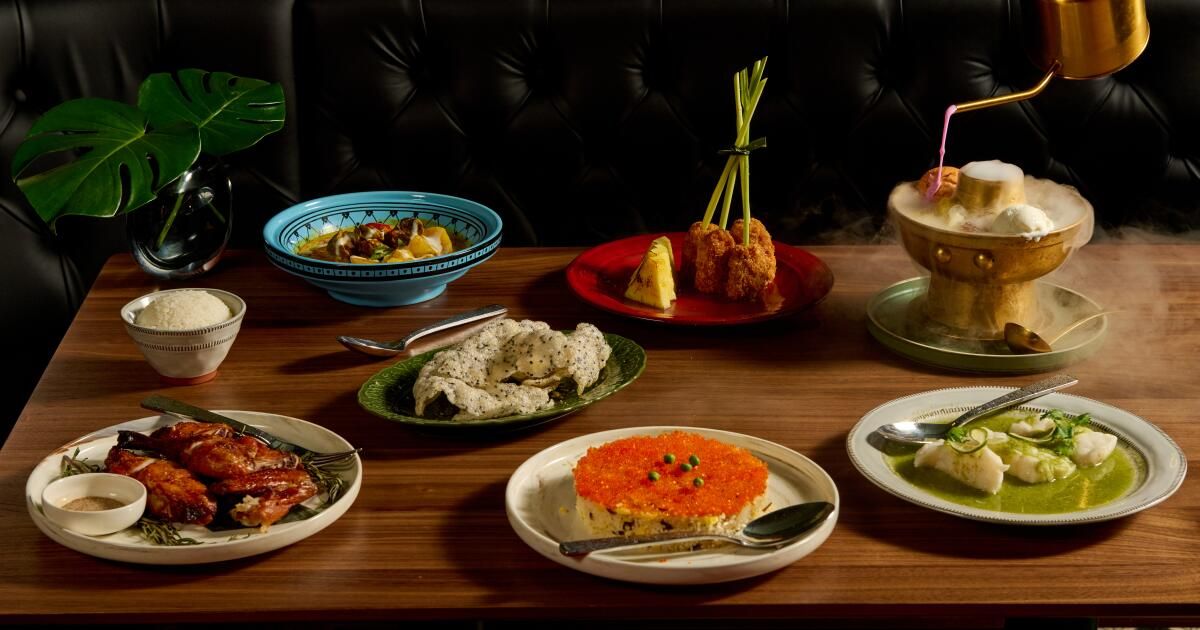The contradictions surrounding Asian chain Star Leaf start with the official number of locations: There are 43 restaurants worldwide. Wait, no. Forty-five. Most of them are in China. One might have a Michelin star. The woman who founded the restaurants is an interior designer who designed all 45 locations. In fact, each location has its own design team. The recipe for Royal Crown fried rice, the restaurant’s signature dish, was purchased after the founder saw the rice in a movie and tracked down the chef who created it. Wait. That’s 43 locations.
The myth surrounding the new Star Leaf in Pasadena, the chain's first restaurant in the United States, rivals that of the Loch Ness monster. The story changes and morphs depending on who you ask and when. Maybe the staff plays a game of telephone before serving.
The exterior of Star Leaf.
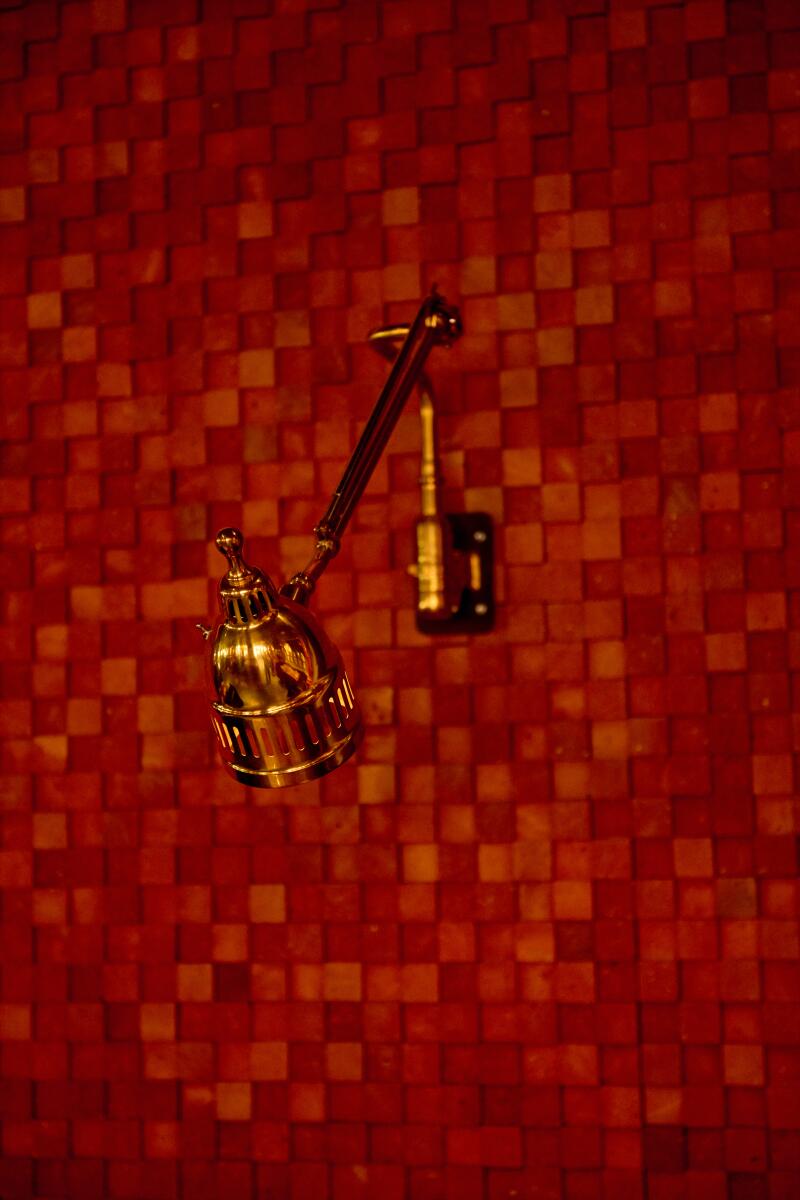
A lamp against the red brick interior of Star Leaf.
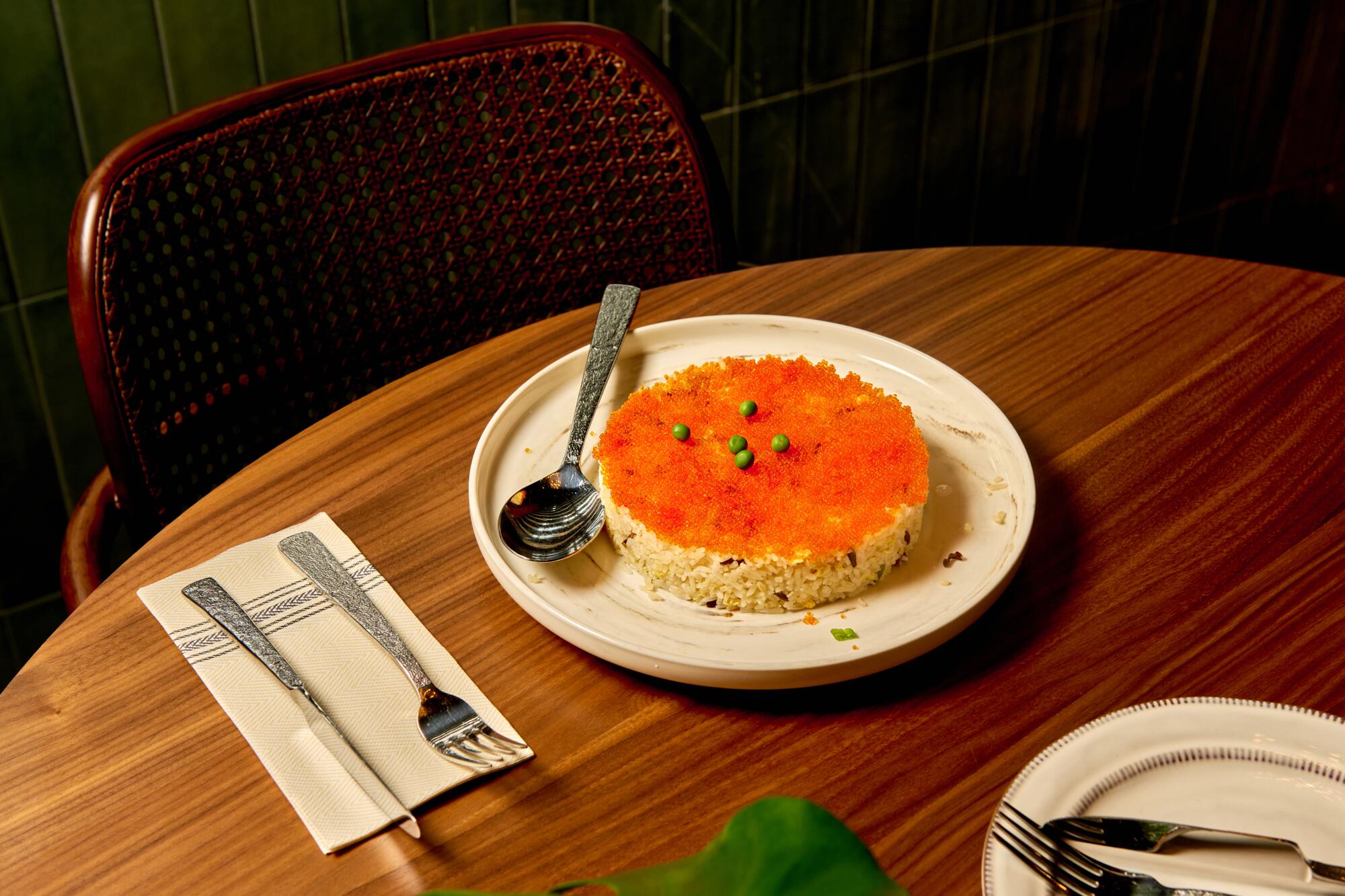
Royal Crown Fried Rice with black and white jasmine rice in a circular mould with chopped shrimp, scallops and spring onions. Topped with a sheet of wild Icelandic capelin roe.
So I set out to understand this enigma of a restaurant that the women in my mother's mahjongg group have been chatting about curiously since it opened in the former Roy's space on Colorado Boulevard in April.
I was also intrigued by a recent online drama. Yelp disabled comments on the restaurant’s page weeks ago, citing an increase in activity, racism, and the need to investigate the content. According to a Reddit thread, the Yelp activity was sparked by an influencer who was denied a free bottle of expensive wine and then accused the restaurant’s staff of being biased.
When I arrived for my first visit, I had a notebook full of questions. The design team members, whoever they are, successfully transformed the space into a luxurious tropical oasis with jade-green tiles on the floor, plush leather booths, and seating that looks like it came straight from the Restoration Hardware showroom. According to the website, the dining room doubles as an art gallery, and all of the artwork is for sale.
Dark wood with intricate moldings lines the walls and tables, palm leaves sprout from strategically placed planters, and slatted curtains complete Tommy Bahama’s luxurious ambiance. It’s the Long Bar at Raffles Singapore reimagined as a sprawling restaurant, complete with an indoor-outdoor fish pond that may or may not contain fish when you visit.
The first question you are asked when you sit down is if it is your first time. Then the waiter tells you his version of the Star Leaf tradition. In my four visits, I received four versions, even though the waiter was the same one twice. It is Southeast Asian food with Thai and Cambodian influences. It is Southeast Asian food that is mainly Thai but with Malaysian influences. Everything is meant to be shared.
Regardless of the narrator, the information is conveyed with seriousness and pride.
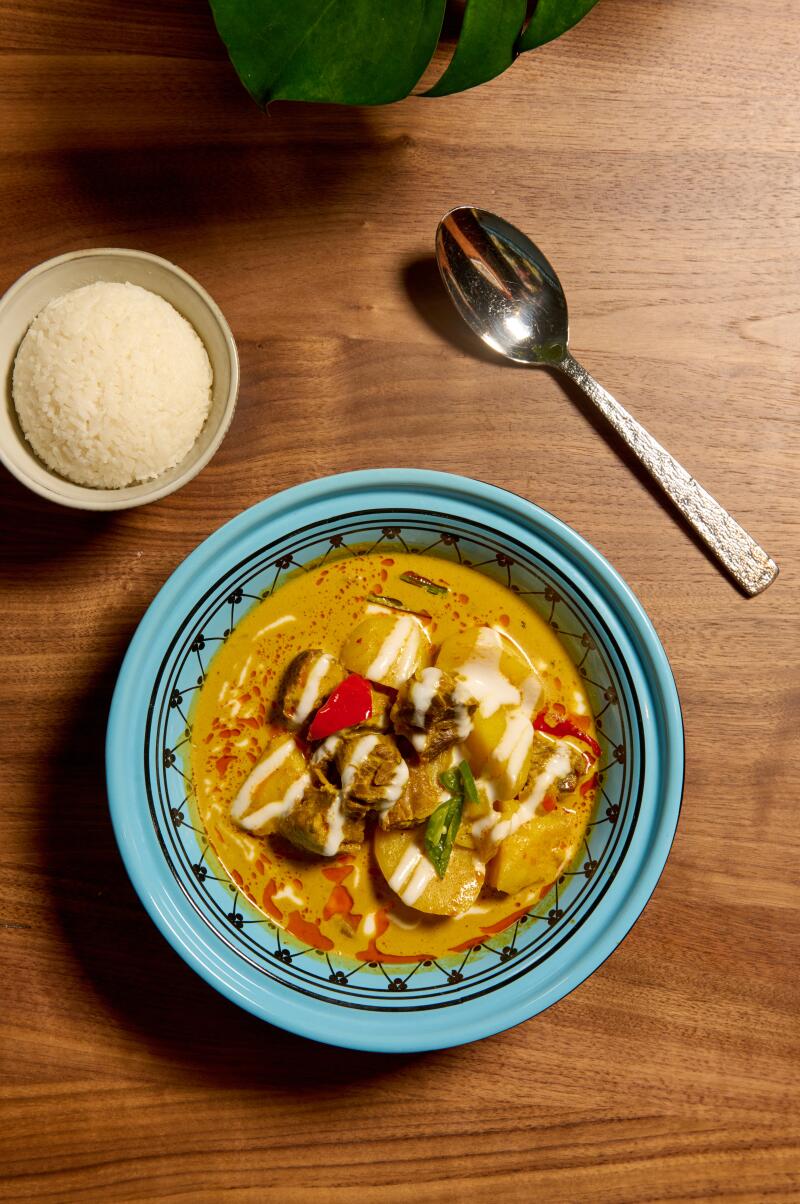
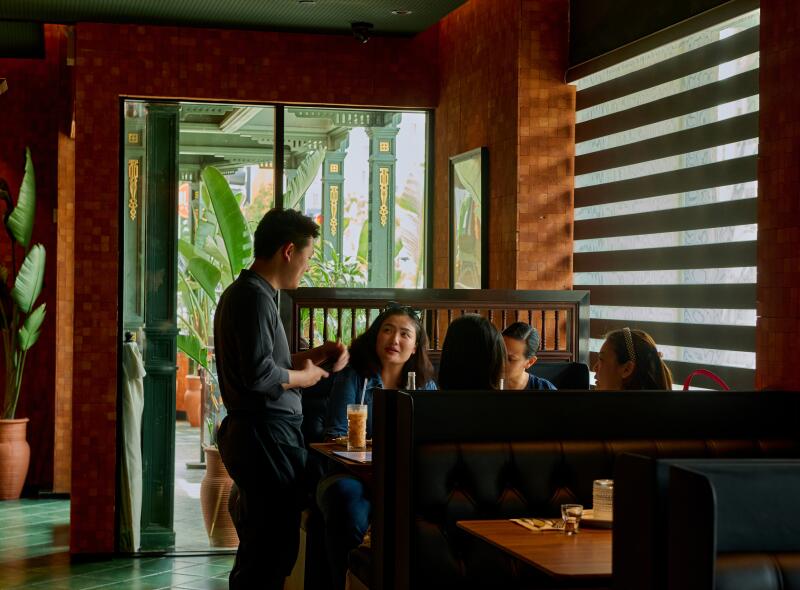
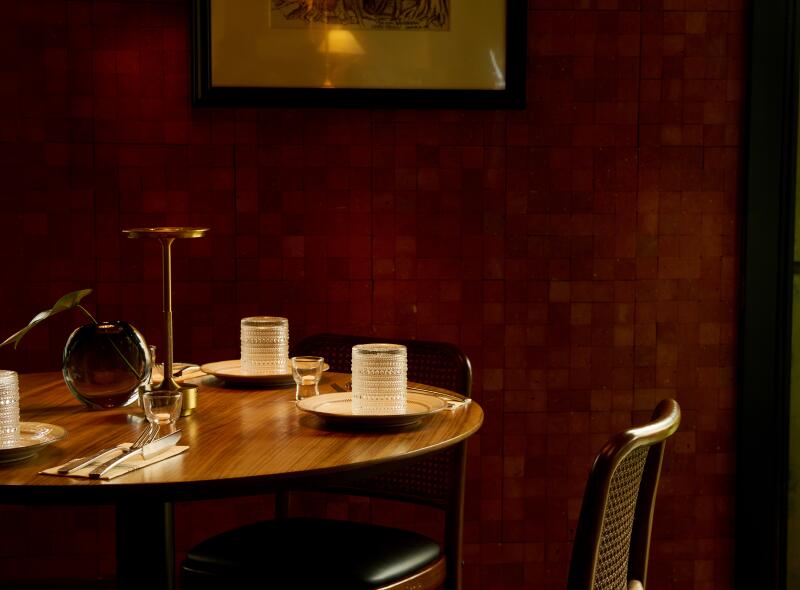
Malaysian captain's curry. Guests place orders inside Star Leaf. A table set in Star Leaf.
Royal Crown Fried Rice does indeed look like the real thing. Black and white jasmine rice is placed in a circular mould with chopped shrimp, scallops and spring onions. Topped is a sheet of orange Icelandic wild capelin roe. The black rice grains are pleasantly chewy. After mixing well, each bite is accentuated by the sweet, crunchy marine notes of the roe. It is just as nice for lunch the following afternoon.
The dish your waiter will recommend more than all the others is the Royal Thai Curry, a monstrous bowl of sauce accompanied by your choice of lobster, soft-shell crab or shrimp.. The menu advertises that it comes with a baked baguette. During one visit, I was asked to choose between rice or bread. The warm baguette is toasted and soft in the middle, like the little buns you might find at your favorite banh mi shop. During all other visits, I was automatically given a bowl of white rice.
The golden sludge slides down the sides of the bowl on its way to the table, almost spilling over the edge. It has a thick, mashed potato flavor, without much spice and with a slightly bitter aftertaste. The egg ribbons dominate the curry like an egg drop soup. Was it supposed to evoke the marbled sauce surrounding the chili crabs I ate at Singapore hawker centers? According to the waiter, it is “based on a traditional royal curry from Thailand.” After asking a few Thai chefs around town, no one could figure out the curry’s origins or any links to Thailand’s monarchy.
The recommended lobster tail was lost in the sauce, and the muddy liquid had as much flavor as a thick Japanese curry, and it swallowed up the bits of delicate seafood. I ended up using the curry as a dipping sauce for the bread, but found that I preferred the baguette on its own.
The soft-shell crab turned out to be a much better match for the sauce. If you're planning on having curry for dinner, the red rainforest vegetable curry is heartier, with a mix of well-cooked broccoli, Brussels sprouts and other vegetables and a slow simmer that gains momentum with each spoonful. But there's one flaw in the starter with all the curries and many of the sauces: the spiciness and funk more associated with Southeast Asian cooking is missing.

Steamed Chilean Sea Bass with Lemongrass and Herb Sauce at the new Star Leaf.

Chicken in banana leaf with crispy skin.
Some of the variations on more traditional Thai dishes, such as crying tiger, are unrecognisable. It is offered as a salad with grilled chicken, steak or tofu. The tenderloin steak will exhaust even the most resistant jaw. On top, a sweet wholegrain mustard sauce slides down the meat. On the side, there is a mound of green salad with wilted lettuce and curls of grated Manchego cheese.
The skin of banana leaf chicken is thin and brittle like that of Peking duck, crisp enough to eat like a French fry. The meat underneath is disappointingly dry.
Chilean sea bass is steamed minutes after it's tender, firming up the flesh until it's just overcooked. It's bathed in an electric green sauce with a sharp kick of lemongrass, cilantro, chile, and mint. It'll become your go-to condiment for anything else on the table.

Mamasan Shrimp Cake Skewers.
Cooking gets a boost with a deep fryer and dessert. Mamasan's shrimp cake skewers are breaded and fried shrimp sausage pieces, loosely constructed and studded with crispy watercress.
Squares of so-called night market tofu are breaded and fried in ground panko breadcrumbs, then sprinkled with a “Japanese seven-spice blend” that is identical to the Chinese five-spice blend. Each piece is deliciously crispy, with a coating that tastes like toasted cereal and a center as soft as custard.
Dessert was always the most enjoyable part of the meal, and the presentations often elicited gasps from my table and those around us. The Pink Mekong is a sight meant for four, a raised silver bowl with dry ice smoke rising from the center. The waiter pours pink coconut cream over the top as the smoke dances across the table. Everyone eats with a spoon, trying to get a little of each component, as if it were a giant glass of Halo Halo. Strawberry-coconut ice creams hug a pile of red beans alongside sliced strawberries, diced green melon, and a pile of lotus seeds. My favorite component may have been the peach gum, little amber-colored nubs of a chewy, sticky substance that I was told comes from the sap of a peach tree. It’s incredibly fun to eat.
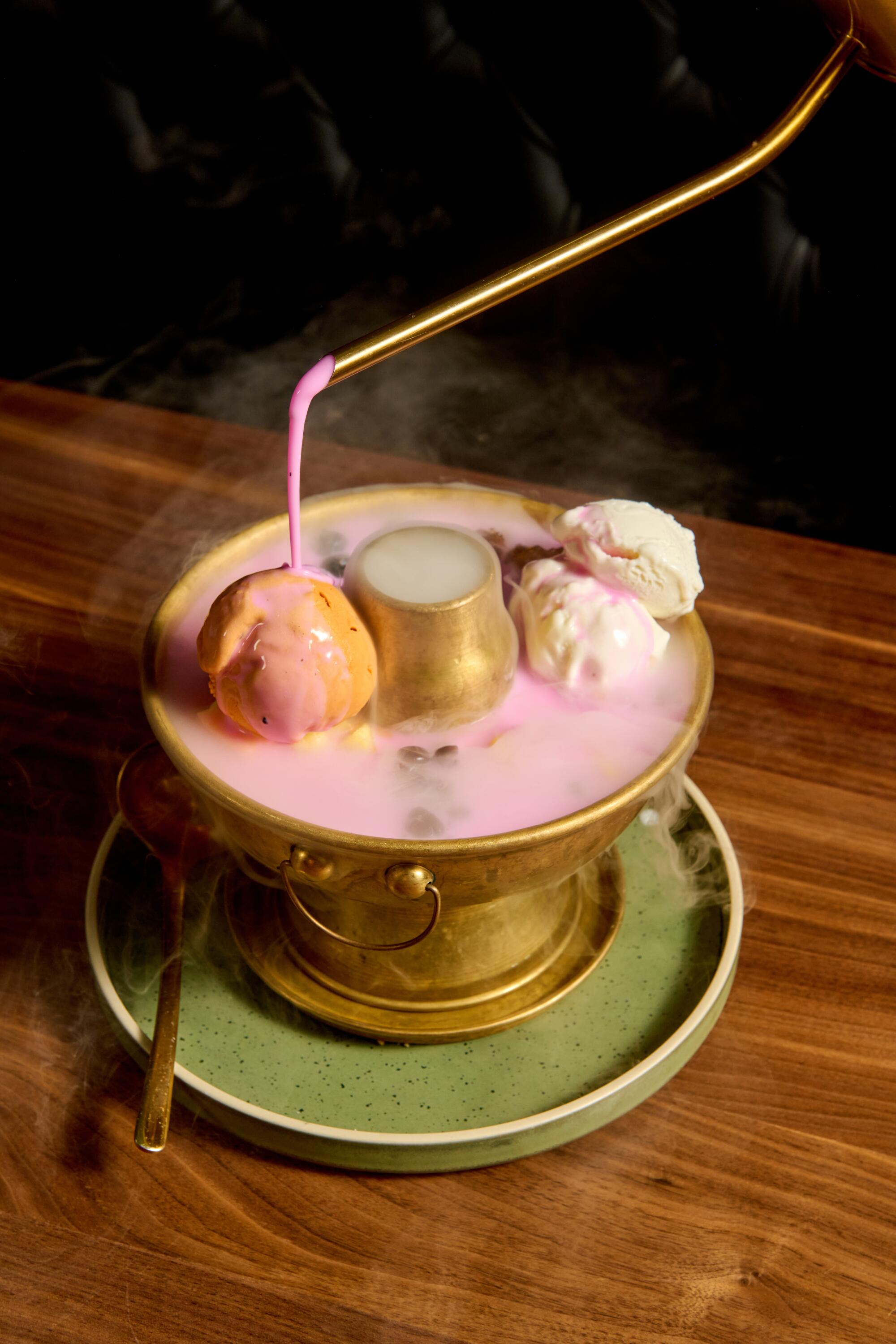
A waiter pours pink coconut cream over the Pink Mekong dessert.
For most of my visits, the months of June and July were dry and I didn’t have any cocktails, but fruit-infused concoctions (and curry) served in fancy glasses were on almost every table. And I can think of far worse ways to spend an evening than with a plate of crispy fried tofu and a Raffles Singapore Sling on the bar.
I may never know the true origin of fried rice or the exact number of locations. I'm still waiting for a response from a representative of the restaurant. If you're enjoying your dinner, I guess it doesn't matter. But the Loch Ness Monster has nothing on Pasadena's Star Leaf.
Star leaf
641 E. Colorado Blvd, Pasadena, (626) 345-5371
Prices: Appetizers $19-$49, main courses $19-$87, desserts $12-$28
Details: Open Monday through Thursday for lunch from 11 a.m. to 3 p.m. and dinner from 5 p.m. to 9:30 p.m.; Friday and Saturday from 11 a.m. to 10 p.m.; and Sunday from 11 a.m. to 9 p.m. Full bar. Street parking.
Recommended dishes: Mamasan Shrimp Skewers, Night Market Tofu, and for dessert, the Pink Mekong and Tropical Panna Cotta Coconut Bowl.

